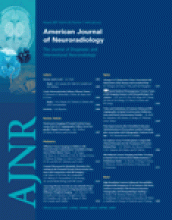Research ArticleBrain
Measuring Elevated Microvascular Permeability and Predicting Hemorrhagic Transformation in Acute Ischemic Stroke Using First-Pass Dynamic Perfusion CT Imaging
K. Lin, K.S. Kazmi, M. Law, J. Babb, N. Peccerelli and B.K. Pramanik
American Journal of Neuroradiology August 2007, 28 (7) 1292-1298; DOI: https://doi.org/10.3174/ajnr.A0539
K. Lin
K.S. Kazmi
M. Law
J. Babb
N. Peccerelli

Submit a Response to This Article
Jump to comment:
No eLetters have been published for this article.
In this issue
Advertisement
K. Lin, K.S. Kazmi, M. Law, J. Babb, N. Peccerelli, B.K. Pramanik
Measuring Elevated Microvascular Permeability and Predicting Hemorrhagic Transformation in Acute Ischemic Stroke Using First-Pass Dynamic Perfusion CT Imaging
American Journal of Neuroradiology Aug 2007, 28 (7) 1292-1298; DOI: 10.3174/ajnr.A0539
Measuring Elevated Microvascular Permeability and Predicting Hemorrhagic Transformation in Acute Ischemic Stroke Using First-Pass Dynamic Perfusion CT Imaging
K. Lin, K.S. Kazmi, M. Law, J. Babb, N. Peccerelli, B.K. Pramanik
American Journal of Neuroradiology Aug 2007, 28 (7) 1292-1298; DOI: 10.3174/ajnr.A0539
Jump to section
Related Articles
- No related articles found.
Cited By...
- Hemorrhagic Transformation Rates following Contrast Media Administration in Patients Hospitalized with Ischemic Stroke
- Variable MR and pathologic patterns of hemorrhage after iodinated contrast infusion in MCA occlusion/reperfusion model
- Focal Low and Global High Permeability Predict the Possibility, Risk, and Location of Hemorrhagic Transformation following Intra-Arterial Thrombolysis Therapy in Acute Stroke
- Evaluating Permeability Surface-Area Product as a Measure of Blood-Brain Barrier Permeability in a Murine Model
- Outcome Differences between Intra-Arterial Iso- and Low-Osmolality Iodinated Radiographic Contrast Media in the Interventional Management of Stroke III Trial
- Using Standard First-Pass Perfusion Computed Tomographic Data to Evaluate Collateral Flow in Acute Ischemic Stroke
- Decreased Infarct Volume and Intracranial Hemorrhage Associated with Intra-Arterial Nonionic Iso-Osmolar Contrast Material in an MCA Occlusion/Reperfusion Model
- Effects of Microvascular Permeability Changes on Contrast-Enhanced T1 and Pharmacokinetic MR Imagings After Ischemia
- Early Rate of Contrast Extravasation in Patients with Intracerebral Hemorrhage
- Delay Correction for the Assessment of Blood-Brain Barrier Permeability Using First-Pass Dynamic Perfusion CT
- Validation of In Vivo Magnetic Resonance Imaging Blood-Brain Barrier Permeability Measurements by Comparison With Gold Standard Histology
- Predicting Transformation to Type 2 Parenchymal Hematoma in Acute Ischemic Stroke by CT Permeability Imaging
- Blood-Brain Barrier Permeability Assessed by Perfusion CT Predicts Symptomatic Hemorrhagic Transformation and Malignant Edema in Acute Ischemic Stroke
- Increased Blood-Brain Barrier Permeability on Perfusion CT Might Predict Malignant Middle Cerebral Artery Infarction
- Recombinant Tissue Plasminogen Activator Increases Blood-Brain Barrier Disruption in Acute Ischemic Stroke: An MR Imaging Permeability Study
- Optimal Duration of Acquisition for Dynamic Perfusion CT Assessment of Blood-Brain Barrier Permeability Using the Patlak Model
- Patterns and Predictors of Blood-Brain Barrier Permeability Derangements in Acute Ischemic Stroke
This article has not yet been cited by articles in journals that are participating in Crossref Cited-by Linking.
More in this TOC Section
Similar Articles
Advertisement











